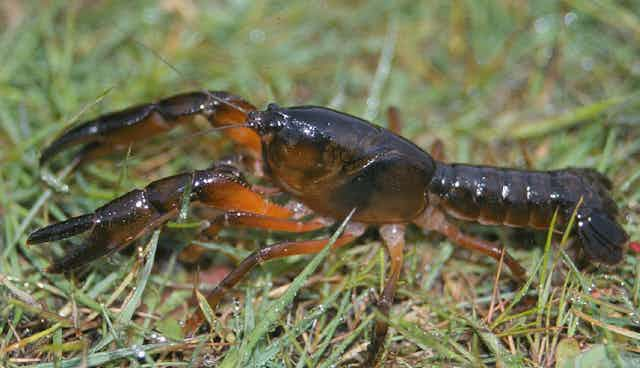Although few people get the chance to meet one, burrowing crayfish rarely fail to catch the imagination. The idea of a little lobster living in a subterranean labyrinth is strange enough to give burrowing crayfish a higher profile than many other invertebrates.
The 35-odd crayfish in the genus Engaeus are widely distributed across southeast Australia and include some of the strongest burrowers. They live in the full range of crayfish habitats, from open waters in swamps to terrestrial burrows in rainforests. Several species have restricted distributions, and where these intersect with heavy land use and vegetation clearance the result is often a threatened species listing.
Two endemic Tasmanian species (Engaeus spinicaudatus and E. granulatus) fall into that category. Both are found in the north of the state, one in a small area just north of Scottsdale; the other between the Mersey River, which meets the sea at Devonport, and eastwards to Port Sorell. Neither species is found in open water, but rather they dig burrows that go down to the water table.
The species name of the Scottsdale Burrowing Crayfish (E. spinicaudatus) refers to the spines found on the tips of its tail fan. This might sound obscure feature to highlight, but having a spiny tail is very rare among crayfish, and indeed all lobster-like crustaceans. Just six out of 120 plus Australian crayfish and nine of the 350 plus North American crayfish have such tail spines. What are they for? No one really knows, but they may be used in grooming, or perhaps to enhance the tail flip escape response, typical of lobsters and shrimps, in the confines of a burrow.
Status
The Scottsdale Burrowing Crayfish has a range of just over 34 km2, and within this it occupies swampy ground, floodplains of creeks and wet buttongrass sedgelands. The area of these habitats has been reduced by vegetation clearance and “improved” drainage, so that the species’ area of occupancy (where it actually lives within its range) is estimated to be just 3.5 km2. Hence it is listed as Endangered under State and Commonwealth legislation.

Although it has a larger range (515 km2), the situation is even worse for the Central North Burrowing Crayfish (E. granulatus). Its range includes some of Tasmania’s best cropping soils, and in this developed agricultural landscape, the animal’s area of occupancy has been reduced to fragmented colonies totalling less than 1 km2. It is also Endangered at State and National levels.
Threats
Both species are mainly threatened by processes that affect the water table (and hence their supply of water), or which physically remove or disturb the soil. Clearance of native vegetation for agriculture or forestry, and drainage works for soil improvement or roading both affect the water supply.
Surprisingly, perhaps, the heavy feet of cattle are more destructive to crayfish burrows than superficial scraping by a bulldozer, so stock present a serious threat to small colonies, particularly alongside streams or watering holes.
Strategy
The Scottsdale Burrowing Crayfish is included in a group Burrowing Crayfish Recovery Plan prepared under the Tasmanian Threatened Species Protection Act, but the threatened status of the Central North crayfish had not been recognised when that plan was written. Both animals are recognised as Priority Species by the Tasmanian Forest Practices Authority.

The main objectives for the recovery of these species are to increase their reservation status and to manage activities in their habitat outside reserves. Both species are increasingly recognised in land use and planning decisions, but the Central North crayfish is more often affected because it sometimes appears in urban areas.
Considerable efforts have been made recently to conserve or relocate animals from urban works such as the renovation of roadside drains and those alongside railway lines. Results so far suggest these strategies have been successful, but the long-term success of relocations has still to be tested.
Conclusion
These two species are the most acutely threatened freshwater crayfish in Tasmania, but the level of recognition by land managers and planning authorities is reason for some optimism that they will be allowed to persist.
The Conversation is running a series on Australian endangered species. See it here

